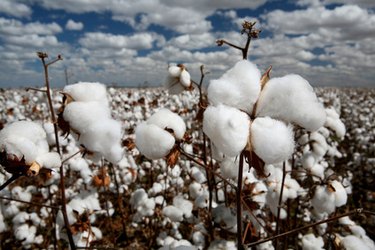
Cotton has a lengthy history that spans many centuries. It is the essential ingredient for the manufacturing of cloth materials. It has been harvested in India for approximately 5,000 years. It is known to have been used in ancient days in North and South America, Egyptians and the Chinese. In 1607, pioneer settlers also raised cotton in their Jamestown settlement. The production process of cotton is an elaborate process that warrants attention for the beneficial product it creates.
Seed Care
Video of the Day
The natural life cycle of the cotton plant originates with mere beginnings in the form of seedlings. Before planting the seeds, the temperature of the soil needs to have maintained an approximate 60 degree F temperature for 10 days. These seeds require being planted in soil that is fertile and moist.
Video of the Day
Planting
Farmers formulate the seed beds by plowing up to eight rows of land.They place the seeds in the ground and cover them with well-packed soil. So as to allow the cotton plant to be nourished by the rich soil, unwanted weeds and grass are excised. The seedlings' roots grow around 9 inches or more into the ground to support the plant. In seven to 10 days, the sprouts begin to appear. From that point on, the plant averages 160 to 180 days to produce the first signs of cotton. The cotton plants grow to an average of 5 feet tall.
Blossoms
After about two months, the blossoms begin to emerge. The original color is white, but they soon become yellow, and then pink. The final color is a rich red. The blossoms live three days before dropping off. Green pods, called cotton bolls, round out the process.
Ripening Process
The inner workings of the boll involve damp fibers that are working toward extending up and out of the seeds. There can be 30 or more seedlings. During the 15- to 25-day ripening stage, they turn into a brown color. The process ends, as the fibers cause the boll to break open, which allows the cotton to make its presence known. The dried cotton will plump up, indicating that it is harvest time.
Aftermath
The final stage entails the final removal of the cotton stalks, after the harvesting has been done. The remains can then be toiled into the surface of the soil. Some farmers, however, choose not to cut the stalks and leave the plant remains on top of the soil.